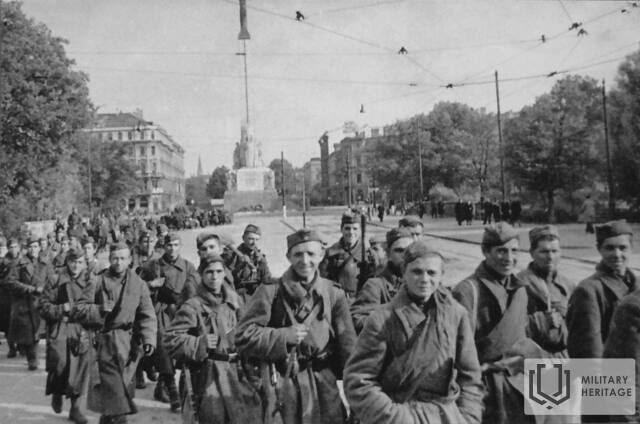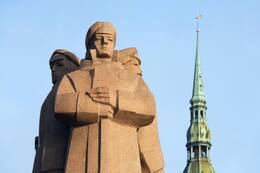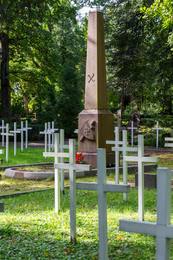Latviai Rusijos imperatoriškojoje armijoje

Latvijos teritorija iki Pirmojo pasaulinio karo pradžios daugiau nei šimtą metų buvo Rusijos imperijos dalis. Latviai dalyvavo visuose pagrindiniuose Rusijos imperijos karuose, tačiau tiesioginių karinių veiksmų Latvijoje nebuvo vykdoma daugiau nei šimtą metų – nuo Napoleono armijos įsiveržimo XIX a. pradžioje. 1914 m., prasidėjus Pirmajam pasauliniam karui, Latvijos teritoriją taip pat paveikė mobilizacija, o į karinę tarnybą pradėti šaukti jauni vyrai nuo 18 metų. Po visuotinės mobilizacijos Rusijos imperijos armijos dydis padidėjo beveik 4 kartus.
Rusijos imperijos armijos ištakas galima sieti su Didžiuoju Šiaurės karu (1700–1721 m.), kai kariuomenėje buvo nuolat atliekami pakeitimai, siekiant pagerinti jos kovinius pajėgumus. Pergale šiame kare buvo įkurta Rusijos imperija, apėmusi buvusios Rusijos carinės valstybės teritoriją ir XVIII–XIX a. užkariautas teritorijas, įskaitant Latviją ir Estiją. Rusijos imperijos armijoje buvo tęsiamos karinės reformos, Latvijos teritorijoje taip pat buvo pradėta diegti šaukimo sistema. XIX a. antroje pusėje daug jaunų latvių ir estų pradėjo mokytis Rusijos karo mokyklose, nes mokslas ten buvo nemokamas ir tai buvo būdas užsitikrinti vietą visuomenėje. Daugelis jų tapo karininkais ir generolais.
Pirmojo pasaulinio karo atneštos karo pastangos Latvijos teritoriją pasiekė jau pirmosiomis dienomis po konflikto pradžios. Jos gyventojams Rusijos imperijos įsitraukimas į karą pirmiausia reiškė mobilizaciją – maisto, drabužių, degalų ir transporto priemonių nusavinimą, viso civilio gyvenimo pajungimą karo poreikiams. Visuotinė mobilizacija, Rusijos imperijoje visu pajėgumu prasidėjusi 1914 m. liepos 31 d., vyko pagal 1910 m. nuostatus, šaukiant į kariuomenę 18–43 metų vyrus. Iš viso karo metais mobilizacijos Latvijos teritorijoje įvyko septynis kartus, mobilizuojant 120–140 tūkst. žmonių. Latvijos kareiviai buvo įtraukti į Latvijos teritorijoje dislokuotus Rusijos karinius dalinius.
20-asis armijos korpusas (literatūroje kartais vadinamas „Latvijos korpusu“) buvo vienas labiausiai kovai pasirengusių Rusijos armijos dalinių, kuris netrukus po karo pradžios dalyvavo kovose Rytų Prūsijoje. Nepaisant pradinių sėkmių, Rusijos armija patyrė pralaimėjimą ir buvo priversta trauktis. 1915 m. vasarį 20-asis armijos korpusas patyrė katastrofą, kai vokiečiai jį apsupo ir sunaikino Augustavo miške (dabartinėje šiaurės rytų Lenkijoje). Žuvų žuvo, dingo be žinios ir buvo paimti į nelaisvę 15–20 tūkstančių kareivių, mobilizuotas Baltijos provincijose (Estijoje, Vidžemėje ir Kurše), dauguma jų buvo latviai.
1915 m. rugpjūčio 1 d. įsakymu Rusijos imperijos armijoje suformuoti latvių šaulių dalinius buvo suformuoti 8 šaulių batalionai, kurie į pirmuosius mūšius stojo jau 1915 m. spalį. Pasibaigus Pirmajam pasauliniam karui, dalis Latvijos šaulių liko Rusijoje ir kovojo Pilietiniame kare įvairiose fronto pusėse, dalis dalyvavo Laisvės kovose Latvijoje. 1921 m., prasidėjus taikai, į Latviją grįžo daug buvusių šaulių, kurie pastaruosius penkerius metus praleido kovodami.
Daugiau informacijos šaltinių
1. Sielų pūga. Skaitmeninis muziejus. Prieinama: https://www.dveseluputenis.lv/lv/laika-skala/notikums/64/1.-pasaules-kara-sakums-latvija/ [žiūrėta: 2021-04-01.].
2. Jēkabsons, Ē. LA.LV leidinys „Nuo valstiečių sūnų iki caro karininkų“, 2014. Prieinama: https://www.la.lv/no-zemnieku-deliem-par-cara-virsniekiem [žiūrėta: 2021-04-01.].
3. Zariņš K. Latvijos karo muziejaus leidinys „1914: mobilizacija ir mūšiai Rytų Prūsijoje“, 2014. Prieinama: http://www.karamuzejs.lv/lv/Petnieciba/publikacijas/01_1914gads.aspx [žiūrėta: 2021-04-01.].
4. Zariņš K. „Pirmasis pasaulinis karas Latvijoje ir Latvijos šaulių mūšiai“, 2015. Prieinama: https://www.sargs.lv/lv/pirmais-pasaules-kars/2015-07-15/pirmais-pasaules-kars-latvija-un-latviesu-strelnieku-cinas [žiūrėta: 2021-05-05.].
Susijusi laiko juosta
Susijusios vietos
Latvijos šaulių paminklas Rygoje
Įsikūręs Rygos centre, Latvijos šaulių aikštėje, netoli Latvijos okupacijos muziejaus.
Latvijos šaulių paminklas buvo atidengtas 1971 m. Latvijos šaulių aikštėje, šalia buvusio Latvijos raudonųjų šaulių muziejaus (dabar Okupacijos muziejus). Sovietmečiu į šią temą buvo žiūrima per siaurą komunistinio režimo ideologinę prizmę. Ši vieta tarnavo kaip Rygos reprezentacija ir idealizuoto pasakojimo kūrimas, sustiprinant mitą apie latvius kaip kovotojus už sovietų valdžią.
Rusijos armijos lengvieji pėstininkų daliniai buvo vadinami šauliais. Pirmojo pasaulinio karo metu Latvijos šaulių junginiai buvo kuriami kovai su Vokietijos armija tėvynėje. Tai buvo motyvuoti, pavojingi ir drausmingi koviniai daliniai. Aukštas išsilavinimo lygis ir vokiečių kalbos žinios buvo naudingos žvalgybai ir netikėtų atakų vykdymui. Žlugus Rusijos imperijai ir Vokietijai visiškai okupavus Latvijos teritoriją, labai daug Latvijos gyventojų atsidūrė Rusijoje, kur toliau susidūrė su bolševikų agitacija. Iš pradžių palaikymas Lenino idėjoms ir dalyvavimas Rusijos pilietiniame kare augo. Vėliau kilo nusivylimas, ir dauguma Latvijos kareivių nusisuko nuo kairiųjų idėjų ir grįžo į Latviją. Dauguma Rusijoje likusių kareivių žuvo per „Stalino valymus“ (1936–1938 m.). Latvijos šauliai labai prisidėjo prie Latvijos valstybės ir jos kariuomenės kūrimo.
Šiandien galite aplankyti paminklą ir gretimą Okupacijos muziejų.
Atminimo akmuo Latvijos šauliams Plakanciems miestelyje
Plakancieme Latvijos šauliai iškovojo pirmąją pergalę istoriniame 1915 m. spalio 29 d. naktiniame mūšyje – praėjus vos savaitei po to, kai 1-asis Daugavgryvos Latvijos šaulių batalionas paliko Rygą ir pradėjo veikti fronte. Sėkmingu Plakanciemo mūšiu prasidėjo mūsų šaulių didvyriškas kelias. Naktinis puolimas prie Misos upės turėjo ir neįkainojamą moralinę reikšmę – niekas neabejojo Latvijos šaulių koviniais sugebėjimais, jie greitai išpopuliarėjo ir daugelis latvių iš Rusijos pulkų prisijungė prie mūsų nacionalinių dalinių.
Atminimo akmenį Kekavos savivaldybė sukūrė Kekavos savivaldybės akmens apdirbimo ir restauravimo įmonė „Akm Stone Processing Center“ – akmenskaldžiai Guntis Pandars ir Pēteris Zvaunis.
Sėkmę Plakanciemo mūšyje užtikrino kruopšti, keturias dienas trukusi nuolatinė žvalgyba, 1-osios kuopos vado Fridriho Briežio parengtas netikėto puolimo planas ir mūsų karių didvyriškumas.
Tuo metu padėtis fronte buvo labai įtempta, nes vokiečių kareiviai keliose vietose lėtai artėjo prie Rygos. Netoli Plakanciemo jie neseniai buvo perplaukę Misos upę ir pradėjo kurtis tilto viršūnę, dislokuodami vokiečių 376-ojo pėstininkų pulko 2-ąjį batalioną ir 4 kulkosvaidžius.
Latvijos šaulių puolimas buvo pagrįstas netikėtumu, greitu veikimu ir įvairių veiksmų koordinavimu. Kiekvienam 1-osios kuopos šauliui buvo duotos po keturias rankines granatas, 60 kareivių apsivilko baltus apsiaustus, nes ką tik buvo iškritęs plonas sniegas. Kai puolėjai priartėjo pakankamai arti vokiečių pozicijų, 22:00 val. buvo duotas signalas ir prasidėjo puolimas. Abu mūsų kulkosvaidžiai šaudė į abu priešo flangus, kad vokiečiai negalėtų pritraukti rezervo. Mesdami rankines granatas, Latvijos šauliai greitai šturmavo vokiečių apkasus, rusų artileristai apšaudė Misos upės tiltus ir pagrindinę priešo gynybos liniją. Priešo kareiviai buvo sutrikę – patyrę didelius nuostolius, jie atsitraukė per upę ir paliko tilto galvutę puolančiųjų rankose. Viena iš mūsų kuopų buvo nugalėjusi keturis kartus didesnį priešo dalinį!
Latvių šauliai neteko šešių žuvusių karių – Jurio Butenieko, Frici Ērmanio, Rūdolfo Hofmanio, Kristapo Krūminio, Jānio Naurio ir Kirijano Šnurovo. Visi jie buvo palaidoti Rygos brolių kapinėse. Iš aštuonių sužeistųjų du vėliau mirė – Jāzeps Brūveris (palaidotas Pleskodālės kapinėse) ir Jānis Skuja (palaidotas Rygos brolių kapinėse). Vokiečių nuostoliai – žuvo 31 karys, 34 pateko į nelaisvę ir 45 buvo sužeisti. Užpuolikai kaip trofėjus paėmė kulkosvaidį ir 35 šautuvus.
Pirmajame pasauliniame kare žuvusių Latvijos šaulių brolių ir Nepriklausomybės kare žuvusių kareivių kapinės
Įsikūręs Valmieros miesto (centro) kapinėse, Lillijos gatvėje 7.
Galima pamatyti granito obelišką, kurio detales nukalė skulptorius Vilhelmas Trejus.
Paminklas buvo atidengtas 1923 m. birželio 22 d. Brolijos kapinėse palaidota apie 150 kareivių.
Miesto kapinėse palaidoti keli Pirmojo pasaulinio karo ir Nepriklausomybės kovų kovotojai, tarp jų ir pirmasis Cėsių pulko Mokyklos kuopos auka žuvęs LKOK Edgaras Krievinis.
Šiuo metu brolių kapinių dalyje yra 14 įvairaus ilgio kapų grupių, ant kurių sumontuoti 139 balti mediniai kryžiai, tačiau anksčiau ant kryžių buvusių lentelių su žuvusiųjų vardais nebėra. Išliko vienas juodo granito kryžius.
Komunistinės okupacijos metu brolių kapinių dalyje buvo vykdomi intensyvūs civilių laidojimai. Atkūrus nepriklausomybę 1994 m., laidojimo išdėstymas brolių kapinėse buvo pakeistas, dabar kapų grupės išdėstytos kryžmai, tik viena išlaikė buvusią orientaciją.
Susijusi istorija
Kieme rastas admirolui Makarovui skirtas atminimo ženklelis.
Mažas karinis reliktas gali papasakoti didžiulę istorinę istoriją. Ir nors ženklelis simbolizuoja įvykius, vykusius Rusijos-Japonijos karo metu, jis taip pat atskleidžia spalvingą karinę istoriją ir mūsų Latvijos šaulių dalyvavimą kituose kariniuose konfliktuose tiek prieš Nepriklausomybės karus, tiek po jų.






